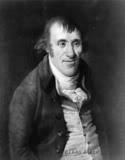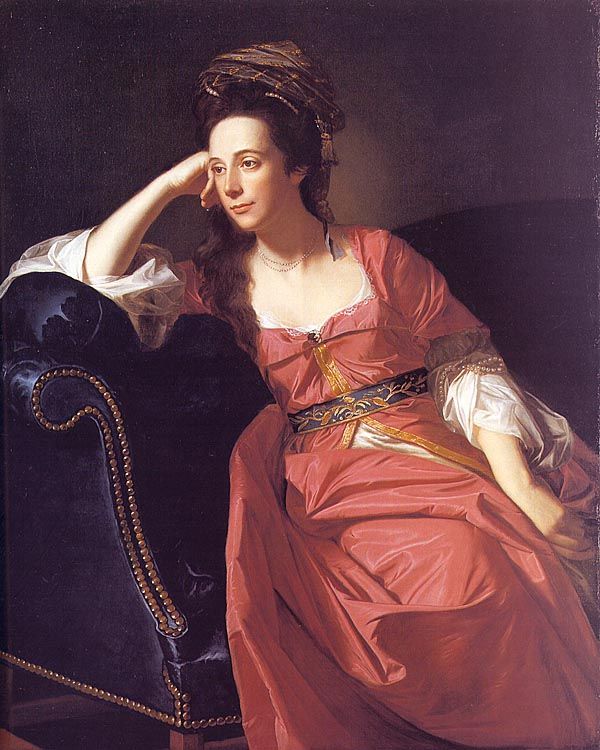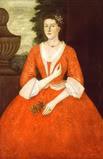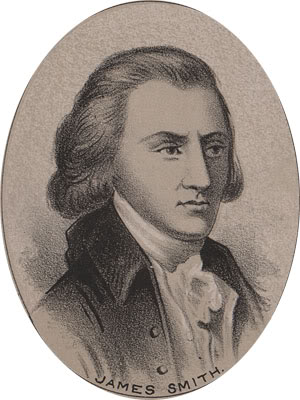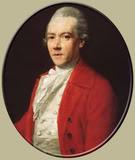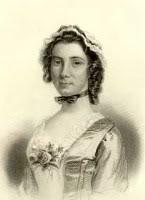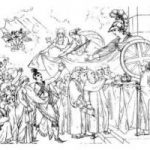Wife of Patriot Ethan Allen
Image: Ethan Allen
Frances Montresor, also known as Fanny, was born April 4, 1760, and grew up in New York City. She was very interested in botany and was an accomplished musician. She was likely the biological daughter of Captain John Montresor. Her stepfather was Crean Brush, a colonel in the British army, who had served under General John Bradstreet at Albany, where he met and married Margaret Montresor, Frances’ mother.
Crean Brush was born about 1725 in Dublin, Ireland, and came to America between 1758 and 1762 and settled in New York City. He was a lawyer and for some time he held the office of Secretary of the Province of New York. He held various offices under the government of New York. He was a representative to the General Assembly of New York from 1773 to 1775, and had large influence in the house.
Mr. Brush owned large tracts of land in Westminster, Vermont, which were confiscated and sold by the Continental Congress, as happened to many Loyalists (British supporters) living in America at that time. The proceeds of the sale went into the public treasury.
During the summer of 1775, he was probably in New York, and in the fall went to Boston, then occupied by the British, and offered his services to General Thomas Gage. The General, who decided to keep his army in Boston for the winter, had his officers vacate homes in the area in order to house his men during the cold winter.
Crean Brush was one of those officers, who was commissioned to receive and protect the private property of the citizens. He seized many goods that were not considered contraband, which were stowed away in vessels in Boston harbor. He set sail for Halifax with his bounty, but was taken when a few days out, and Brush and others were made prisoners.
Brush was examined and committed to the jail in Boston, on charges of having plundered the city, and carried away large quantities of goods and merchandise, which were the rightful property of the townspeople of Boston. He was handcuffed, and denied the use of pen, ink, paper, and candles, and was forbidden to talk to anyone unless in the presence of the jailer.
During his imprisonment, Margaret Brush was allowed to visit him and on November 5, 1778, he escaped in Margaret’s clothes. No one discovered he was gone until the next morning, when his wife was found in his cell. She had left a horse tied at a certain spot, and furnished her husband with the means of escape.
Crean Brush had immediately set out for New York, where he arrived later that month, after an imprisonment of more than nineteen months. He then directed his efforts to the recovery of his property, and compensation for the injuries and the losses he had sustained on behalf of the King. He was unsuccessful in all those things, and felt abandoned by the mother country he had so faithfully served. On a cold morning in the spring of 1779, he decided to end what had become a miserable life, and shot himself in the head.
Mr. Brush had supposedly owned about 25,000 acres of land in the State of New York, and nearly the same amount in the New Hampshire grants, and only a small part of that land was received by his heirs. Brush had written his will in jail in Boston on Oct 18, 1777, and in it bequeathed his landed estate in America to his widow, with the provision that if she remarried, the estate was to be divided in equal shares to his wife, her daughter, Frances Montresor Buchanan, and his own daughter, Elizabeth Brush Norman.
Margaret Brush had remarried by 1783, to Patrick Wall of New York City, relinquishing two-thirds of her share of the estate. Frances had married John Buchanan, a British Naval Officer, in 1776, but he died during the American Revolution. Brush’s daughter Elizabeth married an Irishman, and they set sail for America to claim her share of the property.
Patrick Wall was born in Ireland, and had been a tailor in Boston during the American Revolution. The Walls lived in New York City for a while, and then moved to Westminster, Vermont, where Frances has inherited property from Crean Brush.
Ethan Allen
Ethan Green Allen was born January 10, 1738, in Litchfield, Connecticut to Joseph and Mary Baker Allen. Ethan had eleven siblings, and his father’s death in 1755, was required to look after the family and his younger siblings. This prevented him from going to Yale to pursue an education, a disappointment he felt throughout his life, he was unusually well-read and articulate for a settler of the northern frontier.
During the 1760s, the royal governor of New Hampshire, with no clear authority to do so, began to grant lands in the region now known as Vermont, then called the New Hampshire Grants. After the British King decided that New York’s governor wielded the rightful authority over the territory, the original settlers and their townships were subjected to burdensome New York fees; in some cases settlers found their lands confiscated.
In 1769, Ethan moved to the New Hampshire Grants, and after settling in Bennington, he became prominently involved in the struggle between New York and New Hampshire for control of the region. He did so to protect his own considerable interests, but also the pioneers who came north from Connecticut and Massachusetts after the end of the French and Indian War. Shortly thereafter, he and other family members formed the Onion River Land Company.
After New York authorities rejected an appeal to have the region declared a separate province, the settlers formed a citizens’ militia, called the Green Mountain Boys, to protect their rights and chances of survival, and elected Ethan Allen as their colonel. They took their name from the Green Mountains in Vermont. The royal governor of New York immediately declared Ethan an outlaw.
Ethan preferred to associate the newly developed lands with historically democratic New England rather than New York, where there was a less democratic tradition and a government influenced by wealthy landowners. He even went as far as proposing complete independence for the land between the Connecticut River and Lake Champlain before the Revolution.
At the outbreak of the Revolutionary War, Allen and his force offered their services against the British. The folk hero of Vermont, was an unusually flamboyant farmer-turned-statesman from Connecticut. His giant figure stands on the front portico of the Vermont State Capitol, arm raised to bid defiance to those who would threaten Vermont’s independence and the liberties of her people.
Fort Ticonderoga
The fort is situated at a very strategic point at the southern tip of Lake Champlain, and had been in British hands since the Peace of Paris in 1763. At the outset of the American Revolution a small company of British soldiers still manned the Fort. Ethan Allen recognized the significance of capturing Fort Ticonderoga on Lake Champlain in New York.
On May 10, 1775, Ethan Allen, Seth Warner, and the Green Mountain Boys – a force of 83 men – crossed Lake Champlain from Vermont, and at dawn surprised and captured the sleeping garrison, who had no idea that hostilities had broken out in Concord and Lexington.
Crown Point, another British fort a few miles to the north, was also taken without an engagement the following day. The capture of these two forts secured protection from the British to the north, and provided much needed cannon for the colonial army. Ethan then sent the forts’ store of cannons and mortar to the aid of General Washington at Boston Harbor.
This was the first American victory of the Revolutionary War. Fort Ticonderoga served as an important staging area for the American Army while invading Canada and holding the territory against the British forces until July 1777, when General Burgoyne forced the Fort’s garrison under General Arthur St. Clair to evacuate. The British finally abandoned the Fort the following November, after the surrender of the British army at Saratoga.
Ethan was the guiding spirit in the taking of Fort Ticonderoga, the first Crown property to fall to America, and the source of the cannon that allowed George Washington to drive the British from Boston. Allen left to join the American campaign in Canada, and his Green Mountain Boys were assimilated into the Continental Army.
Imprisonment
In June 1775, Ethan Allen, who was by then at the northern end of Lake Champlain, was somewhat successful at recruiting Indians and disenchanted Canadians to join the campaign to invade Canada, but he never received a commission in the army assigned to the task. Frustrated by delays during the summer, Ethan decided on his own initiative, and in his impulsive fashion, to attack a well-prepared and forewarned Montreal.
A second attack force failed to arrive, and Ethan was easily taken prisoner near Montreal on September 25, 1775, and sent to be tried as a traitor in England. He was first placed aboard HMS Gaspée, a ship of war anchored at Montreal. He was kept in solitary confinement and chains. In October 1775, the Gaspée went downriver, and Allen and the other prisoners were transferred to the Adamant, which then sailed for England.
On arrival at Falmouth, England, after a crossing under filthy conditions, Allen and the other prisoners were imprisoned in Pendennis Castle in Cornwall. However, British political unhappiness over the idea of indefinitely holding people who were arguably prisoners of war without charge as common criminals led to a brief stay there. King George decreed that the men should be sent back to America.
In January 1776, Allen was put on board the HMS Soledad, which sailed for Cork, Ireland. The people of Cork, when they learned that the famous Ethan Allen was in port, took up a collection to provide him and his men with clothing and other supplies.
Much of the following year was spent on prison ships off the American coast. In August 1776, Allen and other prisoners were temporarily put ashore in Halifax, because of extremely poor conditions aboard ship. The food supply was short, both crew and prisoners on short rations, and scurvy was rampant.
By the end of October, Allen was again off New York, where the British had captured the city, and moved the prisoners ashore. He was considered an officer, and his captives gave him limited parole on Long Island. With the financial assistance of his brother Ira, he lived somewhat comfortably until the spring of 1778, when he was jailed for a parole violation that he admitted was “partly true.”
On May 3, 1778, Ethan Allen was marched to New York Harbor, and compelled to board a sloop to Staten Island. He was there admitted to General Campbell’s quarters, and invited to eat and drink with the general and several other British field officers. Allen stayed there for two days and was treated politely. On the third day, he was exchanged for a British officer, who was conducted to the exchange by Colonel Elias Boudinot, the American commissary general of prisoners appointed by General George Washington.
Following the exchange, Allen reported to Washington at Valley Forge. On May 14, he was breveted a colonel in the Continental Army in “reward of his fortitude, firmness, and zeal in the cause of his country, manifested during his long and cruel captivity, as well as on former occasions,” and given military pay of $75 per month. The brevet rank meant that Ethan would be called when needed; his services were never requested, and eventually the payments stopped. He wrote A Narrative of Colonel Ethan Allen’s Captivity (1779), which strengthened the growing myth of this colorful man.
In 1778, Allen appeared before the Continental Congress to make a claim to recognize Vermont as an independent state. With his brother Ira Allen and other Vermonters, he devoted most of his time thereafter to the territorial dispute. He negotiated with the governor of Canada between 1780 and 1783, ostensibly to establish Vermont as a British province. On the basis of this activity he was charged with treason, but since the negotiations were demonstrably intended to force action on the Vermont case by the Continental Congress, the charge was never substantiated.
The Allen family’s land holdings, meanwhile, had surpassed 100,000 acres which they began to sell. To speed settlement, they had harnessed the rivers and built sawmills and grist mills. While, in the end, the land company ruined the Allens’ financially, they had succeeded in opening up the north country.
With the coming of peace, Ethan had begun to put together an impressive farm on the Winooski (Onion) River at Burlington, Vermont. During this period, the self-taught Ethan wrote Reason, the Only Oracle of Man, a philosophical work begun in earlier years with his Deist friend, Dr. Thomas Young. In addition to Ethan’s own reflections, the book also allowed him to berate New England’s clergy for what he saw as their failure to recognize the dignity of ordinary people.
Love and Marriage
Ethan Allen married Mary Brownson in 1762, and had five children with her. Ethan was not an easy man to live with; he was impulsive, a heavy drinker, and frequently absent from home. The family lived in several places in Connecticut, but Ethan finally settled them in Sheffield, Connecticut, sometime in 1767. Mary and her children moved to Vermont during Ethan’s captivity, settling at Sunderland in that year. Mary Allen died of consumption in 1783.
Frances Montresor Brush Buchanan was an attractive and well-educated young widow of twenty-four when she met Ethan in early 1784; he was a widower of forty-six with three young daughters. They met during one of his frequent visits at the home of Colonel Stephen Bradley in Westminster, Vermont, where she and her mother had rooms in the house.
Frances married Ethan Allen on February 16, 1784, after a very brief courtship. Though Frances came from a notably Loyalist background through her stepfather, Crean Brush, they were both smitten, and the marriage was a happy one. They had three children: Fanny (1784), Hannibal (1786), and Ethan Junior (1787).
Frances had a settling effect on Ethan; for the remainder of his life he did not embark on many great adventures. In 1785, his Reason the Only Oracle of Man was published. This book was a financial disaster and not well-received, probably because its ideas were as controversial as its author. It most clearly reflected his personality as a free thinker and an independent spirit.
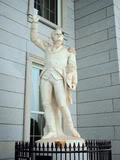
Image: Ethan Allen Statue
By Larkin Mead
Vermont State House, Montpelier.
At the unveiling of this statue in 1941 it was said:
All who passionately love liberty revere the memory of Ethan Allen. Long after this monument to his memory shall have crumbled in decay, his fame will burn with a great light upon the ramparts of the fortresses of liberty. The record of his life will continue to inspire men who love liberty to dare greatly and fight courageously for the cause of human freedom.
Ethan Allen’s Final Years
In his later years, as Vermont continued to experience rapid population growth, Ethan sold a great deal of his land, but also reinvested much of the proceeds in more land. A lack of cash placed a strain on Fanny’s free spending, which was further exacerbated by the cost of publishing his book and of the construction of a new home near the mouth of the Onion River. Ethan was threatened with debtor’s prison on at least one occasion, and was at times reduced to borrowing money and calling in old debts to make ends meet.
In the late summer of 1787, Ethan and Frances moved to Burlington, Vermont, which was no longer a frontier spot but a small town, and much more to Allen’s liking than the larger community that Bennington had become. They lived for three months at Burlington Bay, while the farmhouse was being finished.
Ethan had been planning to settle in Burlington since 1778, when he bought some 150 acres of land on the Winooski River in the northern end of the town. In August 1784, Ethan wrote to his brother Ira, “I have planned the house 34 X 24, two story high, which plan I will now depart from.” The family moved into the newly completed house on the intervale – a low tract of land between hills – in late November.
A letter written by Ethan to Colonel Stephen Bradley of Westminster that same month gives a pleasant impression of this farm and the life he lived on it:
Burlington, 6th November 1787
Sir: I have lately arrived at my new farm of 1400 acres in one body, in which are 350 acres of choice river intervale, a quantity of swales and rich upland meadow, interspersed with the finest of wheat land and pasture land, well watered, and is by nature equal to any tract of land of the same number of acres that I ever saw. I have put forty acres under improvement. The country settles fast, and I wish that you were well settled in it. Little is said about philosophy here: our talk is of bullocks (young bulls) and our glory is in the gad (on the spur of the moment). We mind earthly things.
When Allen moved to Burlington in 1787, his property on the Grand List for that year was 14 pounds. His brother Ira’s was five. The next year, Ethan’s taxable personal property and improved land were rated at 41 pounds and ten shillings. His unimproved lands rated at 25 pounds.
Ethan Allen was fifty years old – an advanced age in the late 18th century – when he came to Burlington to take up the life of a farmer. The last five years of his life were his most tranquil. Heavy rains during the late summer of 1788 and an early frost caused a partial crop failure in northern Vermont.
Consequently, Ethan did not lay in enough hay to get his livestock through the winter. On February 11, 1789, he and his hired man drove the oxen over the ice to South Hero for a load of hay, which his brother Ebenezer Allen had promised him. After an evening spent with friends and acquaintances, he spent the night there, and set out the next morning for home.
Returning early the next morning, Allen either suffered a stroke while returning across the frozen lake, or according to legend, fell from the loaded sleigh in a drunken stupor. Whatever the cause of the trauma, he never regained consciousness. He died on February 12, 1789, at his home, at the age of 51.
Ethan Allen was buried four days later in the Green Mount Cemetery in Burlington. The funeral was attended by dignitaries from the Vermont government, and by large numbers of common folk who turned out to pay respects to a man many considered their champion.
After Ethan’s death, Frances and her children boarded for about a year with the widow of Stephen Lawrence, and then returned to live with her mother in Westminster, Vermont. There, on October 28, 1793, Frances married her third husband, Dr. Jabez Penniman, who also assumed responsibility for her minor children.
Despite a conflict over the intervale property, Fanny and her new husband lived there from 1794 until 1800. During the last years of her life, Frances lived at Dr. Penniman’s hometown of Colchester, Vermont, and had several children.
Frances Montresor Buchanan Allen died in 1834.
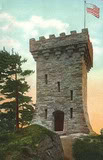
Image: Stone Tower
Ethan Allen Park
Burlington, Vermont
In 1902, William J. Van Patten bought the property in Burlington that was once Ethan Allen’s for $20,000. Appreciating its historical significance, Van Patten set apart about 12 acres, including the ledge of rock now enclosed by the park, and offered it to the Sons of the American Revolution on condition that a stone tower, a memorial to General Ethan Allen, be erected on the top of the ledge and a road built leading to the tower and to Ethan’s former house. Accepting the offer, the S.A.R. Built and dedicated the present tower in 1905.
Ethan Allen made a significant contribution to the early history of Vermont, at that time called the New Hampshire Grants, which then constituted the northern frontier of the New England colonies.
SOURCES
Crean Brush
Wikipedia: Ethan Allen
Ethan Allen (1738 – 1789)
Mrs. Frances Montresor Buchanan
